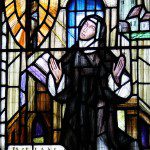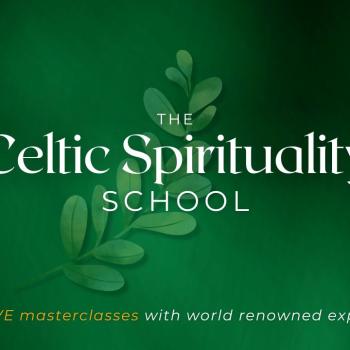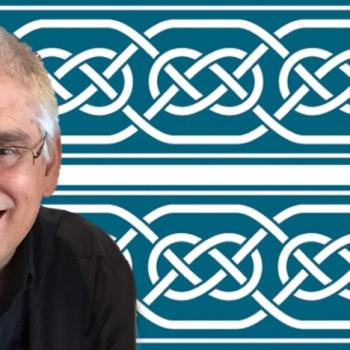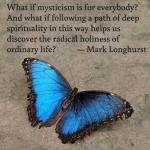 Friends, I am in the process of writing a book about Celtic spirituality. This will be the first book on Celtic wisdom that I have written since becoming a Catholic in 2005. Over the next few weeks I hope to post excerpts from the manuscript to this blog, both to share with you what’s on my mind these days but also to garner any comments or feedback you’d like to share. Please remember that this is “unvarnished” writing — the book itself will be carefully edited and revised, so the text that you see here on this blog may change, slightly or considerably, before getting published. With that in mind, please let me know what you like, what you don’t like, what questions or comments you might have, about any of these Celtic posts that I share over the next few weeks. And thank you for reading, and for your interaction!
Friends, I am in the process of writing a book about Celtic spirituality. This will be the first book on Celtic wisdom that I have written since becoming a Catholic in 2005. Over the next few weeks I hope to post excerpts from the manuscript to this blog, both to share with you what’s on my mind these days but also to garner any comments or feedback you’d like to share. Please remember that this is “unvarnished” writing — the book itself will be carefully edited and revised, so the text that you see here on this blog may change, slightly or considerably, before getting published. With that in mind, please let me know what you like, what you don’t like, what questions or comments you might have, about any of these Celtic posts that I share over the next few weeks. And thank you for reading, and for your interaction!
The Three Streams of Celtic Spirituality (and Three Lessons We Learn from it)
A Benedictine monk in Ireland suggests that there are “three streams” to Celtic spirituality.
Seán Ó Duinn is a member of Glenstal Abbey in Co. Limerick. He is an expert on Irish history and Celtic spirituality, having written books on St. Brigid and the folklore associated with the ancient megalithic sites of Ireland. Like a sleuth, this scholarly monk has unraveled layers of stories, legends and lore to shed light on the intricate web of relationships between the various ages of Irish spirituality. His book, Where Three Streams Meet: Celtic Spirituality has given me much insight into the history of Celtic wisdom.
 First came the megalithic (stone age, or pre-Celtic) age, which gave us the ancient sacred sites that still stand like mute sentinals on the windswept landscape: stone circles such as those found at Drombeg in Ireland or Callanish in Scotland; dolmens — standing stones which look like tables or altars, but are actually the remnants of prehistoric tombs; and more elaborate grave sites such as Newgrange, the remarkable artificial mound oriented so that the sunrise of the Winter Solstice illuminates the tiny passageway into the central chamber where three tombs lay under an elaborate corbeled roof. Most of the evidence of the culture and spirituality of these ancient megalithic people comes to us through the silence of archaeological remains, although plenty of the folklore and myth that developed in the following ages is associated with these prehistoric sites.
First came the megalithic (stone age, or pre-Celtic) age, which gave us the ancient sacred sites that still stand like mute sentinals on the windswept landscape: stone circles such as those found at Drombeg in Ireland or Callanish in Scotland; dolmens — standing stones which look like tables or altars, but are actually the remnants of prehistoric tombs; and more elaborate grave sites such as Newgrange, the remarkable artificial mound oriented so that the sunrise of the Winter Solstice illuminates the tiny passageway into the central chamber where three tombs lay under an elaborate corbeled roof. Most of the evidence of the culture and spirituality of these ancient megalithic people comes to us through the silence of archaeological remains, although plenty of the folklore and myth that developed in the following ages is associated with these prehistoric sites.
Next came the Celtic age itself, an age of myth and poetry and stories, a time when warriors and druids shaped the destiny of the tribal peoples. We don’t know exactly when the Celts came to the lands that now most popularly carry their identity: Ireland, Scotland, Wales, Cornwall, the Isle of Man, Brittany, and Galicia in Spain. There’s even lively debate over whether the movement of Celtic culture into these lands came gradually and peaceably, or more suddenly as a result of invasion and conflict. Certainly the Celtic myths themselves have a warlike feel to them; indeed, the foundational text of Irish mythology is called the Book of Invasions. But regardless of how the Celts arrived in their eventual homelands, the tales of gods and goddesses, warriors and poets, bards and seers, druids and lovers, formed the heart of their wisdom and spirituality, that soon became synonymous with the lands where this distinctive culture took root.
The third stream represents the coming of Christianity. Once again, exactly how this happened has forever been shrouded in mystery. We have legends such as the evangelisation of the Irish by St. Patrick or of Scotland by St. Columcille; but the evidence supporting the popular legends is sparse and contradictory evidence makes the storyline far less certain. Perhaps Patrick came to Ireland many years after an earlier missionary named Palladius, for example. Or were Palladius and Patrick contemporaries, or even two names of the same person? No one knows for sure. But we do know the Christians did come, and when they did they stepped out from the confining safety of the Roman empire to bring the message of Christ and his mercy and hope to a culture and a people radically unlike the familiar contours of “civilized” society.
And what happened when the Celts became Christian? Certainly they embraced the stories of Jesus and his apostles, as well as the emerging literature from the mystics of the deserts of Egypt and Palestine. But Celtic Christianity represented not so much the imposition of one religious identity on top of another, but rather the marriage or blending of the two. Christians brought their stories and insights into a God of mercy and forgiveness, incarnate in the healer and wonderworker from Nazareth; but the Celts responded by writing poetry that articulated their devotion, retreating into the wilderness to find remote places for prayer and sanctity, and — most surprising of all — committing the ancient pagan lore of their ancestors to writing, something the druids themselves refused to do but that the monks who followed Christ did so with exuberance. So, paradoxically, we have the Christians to thank for the preservation of pagan lore.
So the three streams of megalithic archaeology, pagan myth, and Christian lore combine together to give us the rich and heady waters of Celtic spirituality. It may not be the only kind of spirituality that emerged from the encounter between previously alien wisdom traditions — Christianity itself is the child of Jewish monotheism and Greco-Roman philosophy — but Celtic spirituality is a unique portal into the mysteries of the Spirit, a portal that may be more essential and relevant — not just for Celts, but for all people — than ever.
What can we learn from such a messy history?
When I gaze into the rushing and singing waters of the three streams, here’s what I see:
First, I see that the stories we tell shape who we are. The ancient, prehistoric sites — from Newgrange to the stone circles to the old stone tables and the so-called fairy rings — all took on new life and new meaning when they were woven into the myths of the Celts. Newgrange was no longer an astronomically sophisticated burial place: it became the ancestral home of the gods who lived in the underworld. We can sanctimoniously dismiss the myths because they tell tales that “aren’t true,” but then we miss the insight into human nature or the mysteries of the soul that are encoded within their symbolism and stories. C. S. Lewis is a helpful guide here: even though he regarded the Christian story as the only “true myth,” he continued to draw from the wisdom and wit of many other legends and lore to celebrate their capacity to entertain us, and even more important, to teach us important truths about who we human beings really are.
Next, in the three streams of Celtic spirituality I see that the present and the past are in conversation with one another, and perhaps with the future as well. When the pre-Celtic megalith builders died out and were supplanted by the story-telling Celts, their land and their monuments spoke to the Celtic imagination — and that imagination, in turn, brought light to the Christian monks who sought to keep knowledge and wisdom alive during the so-called dark ages. What does this mean for us today? What’s beautiful about Celtic spirituality is that it brings these three streams of wisdom to us, here and now, calling us to embrace the insights of the past as a way to sculpt meaning and purpose for our lives today — and to chart a direction for how we can live into our future with grace and compassion.
Finally, I notice that myth has a way of conveying truth and wisdom and insight that operates entirely outside the narrow ground-rules of scientific thinking or modern scholarship. When I say this, I don’t mean to dismiss the importance of scientific knowledge — so much of life today is enhanced and supported by technology and resources that come to us through our amassed knowledge. But even the most carefully calibrated technical knowledge has its limits. Can science measure love, or chart compassion, or map the path to resolve a finely nuanced ethical conundrum? Myth invites us into realms of wonder, of devotion, of sacrifice, of virtue, or paradox and mystery, of hope when all seems lost and compassion against all common sense. It snaps us out of the limitations of a linear mind into the creative possibilities of a future no one yet knows.
So Celtic spirituality makes us more complete as human beings. It does not compete with the empirical knowledge that shapes so much of modern life, but rather invites us into a wondrous otherworld where poetry and myth offer to shape us as well — and just as ordinary human knowledge teaches us the secrets of our phyiscal universe, the “unknowing knowledge” of poetry and myth teach us the secrets of our souls, created as they are in the image and likeness of God. Celtic spirituality is not the only or exclusive portal into the realm of myth and wonder — but it is one such doorway, and one well worth exploring.
Enjoy reading this blog?
Click here to become a patron.














